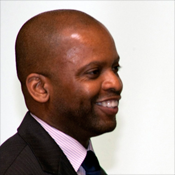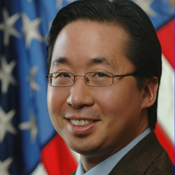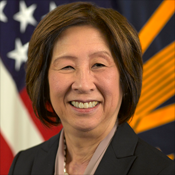On <em>InformationWeek</em>'s Government CIO 25, we profile the top public sector tech executives who are driving big changes in government IT.


10 Breakthrough DARPA Technologies
10 Breakthrough DARPA Technologies(click image for larger view and for slideshow)
A top CIO in government wears many hats. Faced with declining budgets, particularly at the state and local levels, public sector IT execs are becoming more creative in how they manage IT costs. Meanwhile, they're working hard to address their biggest challenge: modernizing antiquated IT systems.
InformationWeek's Government CIO 25 recognizes those leading CIOs in federal, state and local government, who share qualities such as technology vision, clout among peers in other agencies, and an ability to show concrete results.
Our power list includes Department of Energy CIO Robert Brese, who launched Energy.gov on an open-source content management system and oversees the agency's annual $2 billion investment in IT. Thanks to list maker Joe Klimavicz, CIO of the National Oceanic and Atmospheric Administration and early adopter of cloud computing, NOAA employees now use Google Apps, a cloud-based productivity set of applications. The Defense Department's Teri Takai, who is among a handful of female government IT leaders, has spearheaded various initiatives, including a modernization plan, since joining the Pentagon in 2010.
There are high expectations for the CIOs on our list. Just look at the White House's 25-point plan to eliminate failing IT programs, which CIOs have been using to identify areas that need work. The majority of tech execs (94%) are implementing the plan by deploying cloud services, according to a survey of 41 public sector CIOs released in May by TechAmerica. However, CIOs are struggling with government-wide implementation due to serious cost and security constraints.
[ Download the entire May 2013 issue of InformationWeek Government here.
Then there is the Digital Government Strategy, introduced by the Obama administration in May 2012. Whitehouse.gov describes the strategy as created to build a "21st-century government" that offers services to the public "anywhere, anytime, on any device." The strategy focuses on open government data, which, if publicly accessible in easy-to-use formats, can fuel innovation and economic growth.
The strategy's ultimate goal is to make government "more transparent, more efficient, and more effective." But those aren't easy goals for CIOs with limited budgets and security concerns, the latter a problem especially because of the sensitive nature of government data. That's why our list includes IT leaders who are driving change on the mobile front. City of Boston's CIO Bill Oates, for example, was at the forefront of Citizens Connect, a mobile app that lets residents report problems to city managers.
The importance of technology in government cannot be stressed enough. For that reason, InformationWeek Government carefully selected the movers and shakers in government IT by reviewing their qualifications and achievements. The Government CIO 25 are the best among IT leaders. Here, in alphabetical order, are the detailed profiles of each.
1. Lonny Anderson, CIO, National Security Agency
Anderson has led the NSA's development of a widely used framework for lightweight Web applications, as well as the agency's work in big-data analytics. The NSA also developed a cloud-computing environment that will be shared with other U.S. intelligence agencies as part of an enterprise IT strategy from the Office of the Director of National Intelligence.
2. Frank Baitman, CIO, Health and Human Services
Health and Human Services has started down the path of commodity IT consolidation under Baitman, who joined the agency last year. Baitman had previously served for two years as CIO of the Social Security Administration, where he was brought in to modernize the agency's IT infrastructure, but resigned after senior officials decided to narrow the CIO's authority.

Michael Basla
Michael Basla Photo: CIO Council3. Lt. Gen. Michael Basla, CIO, Air Force
As the Air Force's top tech exec and "chief of information dominance," Gen. Basla is responsible for the Air Force's networks, communications, and information management and assurance, and for providing support to 77,000 cyber operations and support personnel around the world. He also has a hand in strategy and policy for the Air Force's cyberspace operations.
4. Robert Brese, CIO, Department of Energy
Brese was appointed CIO at the DOE in July 2012, after serving as deputy CIO for IT of the National Nuclear Regulatory Administration. Some of his first actions included launching Energy.gov on an open-source content management system in a cloud environment and migrating the agency's public-key infrastructure to a shared service provider. He is chairman of the federal CIO Council's Management Best Practices Committee.

Adrian Gardner
Adrian GardnerPhoto: NASA Goddard Space Flight Center5. Adrian Gardner, CIO, NASA Goddard
Gardner was formerly CIO for the National Weather Service and before that served in senior IT positions with the Department of Energy. At Goddard, he has led initiatives in cloud computing, high-performance computing and government transparency. One of his highest-profile projects was the deployment of cloud computing in a portable container.
6. Brett Goldstein, CIO, City of Chicago
Before being appointed CIO by Chicago Mayor Rahm Emanuel in June 2012, Goldstein was the city's chief data officer. Before that he headed the Chicago Police Department's predictive analytics group. Now, he's applying that know-how more broadly. Chicago is investing in predictive analytics with a long-term goal of addressing serious issues such as the murder rate and emergency response.
7. Terry Halvorsen, CIO, U.S. Navy
The no-nonsense Halvorsen has pushed hard to manage through fiscal belt tightening with mandatory cuts, enterprise licensing and improved IT governance. He's leaving no stone unturned. In a bid to lower the costs of using printers, copiers, fax machines and scanners, Halverson instructed Navy personnel to print in black and white whenever possible.

Karen Robinson
Karen RobinsonPhoto: Texas Department of Information Resources8. Karen Robinson, CIO, State of Texas
As executive director for the Texas Department of Information Resources, CIO Robinson manages the state's IT and communications planning, procurement, service delivery, data center services, IT security and state website, Texas.gov.
9. Grant Schneider, CIO, Defense Intelligence Agency
Schneider's work at the DIA includes development of new information-sharing systems, client virtualization and adoption of cloud computing. The DIA runs the military and intelligence communities' top secret intranet. Schneider was previously chief of the agency's enterprise IT operations group, where he helped to centralize military intelligence IT efforts.

Malcolm Jackson
Malcolm JacksonPhoto: EPA10. Malcolm Jackson, CIO, Environmental Protection Agency
Jackson came to the EPA in 2010 from the private sector, where he worked for Cigna Group Insurance as senior IT business unit leader and in other roles. At the EPA, he's responsible for IT planning, investment, security, information quality and collection, and access to environmental information including the Toxics Release Inventory.
11. Joe Klimavicz, CIO, National Oceanic and Atmospheric Administration
Klimavicz has been an early adopter of cloud computing and, owing to his agency's scientific mission, of big-data platforms and processes. The NOAA has migrated 25,000 employees to Google Apps and made the switch from BlackBerry devices to iPhones. It's a heavy user of supercomputers for its climate research and forecasting.
12. Lt. Gen. Susan Lawrence, CIO, U.S. Army
As CIO of the Army since 2011, Gen. Lawrence oversees command, control, communications and computers, the so-called C4 functions. She also bears the designation G-6, a reference to her role as advisor on networks, communications and signal operations to the Army chief of staff.

Sasi Pillay
Sasi PillayPhoto: NASA13. Sasi Pillay, CTO for IT, NASA
In addition to leading NASA's mobility strategy and big-data efforts, Pillay works to find new technologies to integrate into NASA's broader IT infrastructure. He previously was CIO of NASA's John H. Glenn Research Center in Cleveland. Pillay's academic credentials are impressive: he has a degree in mechanical engineering from Penn State University, a master's degree and Ph.D. in computer engineering from Case Western Reserve University, and a master's degree in tech management from MIT's Sloan School of Management. 14. Luke McCormack, CIO, Department of Justice
In March 2012, McCormack stepped in as CIO at the DOJ, where he provides oversight of IT efforts that extend across the department's various component organizations. Before taking the DOJ job, he served for seven years as CIO at Immigration and Customs Enforcement in the Department of Homeland Security. McCormack is co-chair of the federal CIO Council's Information Security and ID Management Committee. He has private-sector experience with MCI and Ford Aerospace.
15. Rahul Merchant, CIO and Chief Innovation Officer, New York
It was notable when New York Mayor Michael Bloomberg named Merchant to be city CIO in April 2012 not just because of the size and scope of the job -- he oversees the Department of IT and Telecommunications, with a staff of 1,200 -- but because Merchant wears a second hat as chief innovation officer. He's part of the city's ambitious plan to become a global tech hub by encouraging startup activity, business development and tech training.
16. Terry Milholland, CTO, Internal Revenue Service
Milholland has been instrumental in helping the IRS modernize is outdated tax-management systems. In 2012, after years of trying, the agency finally implemented a database management system called the Customer Account Database Engine 2, or CADE 2, that expedited tax processing and put more up-to-date information in the hands of the agency's call handlers. Before coming to the IRS in 2008, Milholland was a technology executive at Visa International, EDS and Boeing.
17. Bill Oates, CIO, City of Boston
Oates has been building Boston's reputation as a "smart" city through the use of analytics software and other technologies. Projects include Citizens Connect, a mobile app that lets residents report potholes and other problems to city managers; deployment of asset management software at the Public Works Department; and an operations dashboard at the Office of Arts, Tourism and Special Events.

Todd Park
Todd ParkPhoto: White House18. Todd Park, Federal CTO, Office of Science and Technology Policy, White House
Since being appointed federal CTO in March 2012, Park has brought enthusiasm, energy and new ideas to the federal government's tech strategy and investments. Previously CTO of Health and Human Services, Park brings an entrepreneur's approach to government service, having co-founded several health IT startups. He's a vocal proponent of open government and has helped drive innovation through "health data paloozas" and the Presidential Innovation Fellows program.
19. Jerome Pender, CIO, FBI
A 10-year veteran of the FBI, Pender was appointed CIO in August 2012. Prior to that, he served as deputy assistant director of the agency's Criminal Justice Information Services Division, which manages both the national background check system and fingerprint identification system. The FBI has contracted with Accenture Federal Systems to modernize the National Instant Criminal Background Check System, the key platform used in firearms background checks.
20. Margie Graves, Deputy CIO, Homeland Security
As deputy CIO of Homeland Security since 2008, Graves was forced to step in as acting CIO in March 2013 when agency CIO Richard Spires took a personal leave of absence. Spires resigned in May and Graves continues to serve as deputy CIO. She manages the operations of the Office of the CIO and oversees IT architecture, infrastructure and security.
21. Richard Holgate, CIO, Bureau of Alcohol, Tobacco, Firearms and Explosives
Holgate has led numerous IT projects at ATF, including mobile development and deployment, moving the agency's email system to the cloud, creating an email archive online for e-discovery and making aggregate gun-trace data available in an open format. Holgate's biggest and most important IT project is still to come: an upgrade to the agency's outdated Firearms Tracing System.
22. Al Tarasiuk, CIO, U.S. Intelligence Community
Working in the Office of the Director of National Intelligence, Tarasiuk oversees IT strategy and implementation for the 17-member Intelligence Community. He's using his position to encourage wider adoption of cloud computing and other kinds of shared services and platforms. He works with the CIOs of the CIA, the Defense Intelligence Agency, the National Geospatial-Intelligence Agency, the National Reconnaissance Office and the National Security Agency to advance an IT strategy that spans the various intelligence agencies.

Teri Takai
Teri TakaiPhoto: DOD23. Teri Takai, CIO, Department of Defense
Since joining the Pentagon in 2010, Takai has launched several department-wide IT initiatives, including an enterprise IT strategy and roadmap, a 10-point modernization plan, a cloud computing strategy and a mobility strategy that makes for increased use of commercial smartphones and wireless infrastructure.
24. Jeanne Tisinger, CIO, CIA
Tisinger was appointed CIO of the CIA in July 2010. She reports to CIA director John Brennan and oversees the agency's IT and information management programs. The CIO also serves as the agency's senior official for privacy matters, coordinating internal and external information-sharing policies.

Steven VanRoekel
Steven VanRoekelPhoto: CIO Council25. Steven VanRoekel, federal CIO, Office of Management and Budget
VanRoekel has been busy since stepping in as federal CIO in mid-2011, driving forward existing OMB policies such as "Cloud First" while introducing new ideas and policies of his own. Some of his biggest projects have included the government-wide Shared Services Strategy and Digital Government Strategy, both introduced in May 2012. More recently, he relaunched the government's IT portfolio management program as PortfolioStat 2.0, tying it more closely to data center consolidation efforts.
About the Author(s)
You May Also Like







